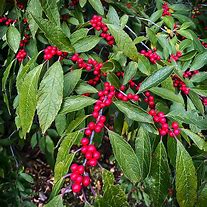Holly Winterberry Red
$39.99
Holly Winterberry………Ilex verticillata
Common Name: Winterberry Holly
Winterberry holly is a slow-growing, woody, deciduous tree or shrub native to Eastern North America and a member of the holly family (Aquifoliaceae). The common name refers to the plant’s red berries that mature in the fall, providing winter interest and food for birds and small mammals. The species epithet means "having parts in whorls" and refers to the clusters of fruits appearing like whorls at the nodes of the shoots.
Winterberry holly requires moist, acidic soil with good drainage in deep or partial shade, or full sun. It tolerates heat, drought, and soil compaction. It may abort fruit set in dry soil. It is resistant to deer foraging, fire and salt. To produce berries, the plant must be properly cross-pollinated. Match blooming times with a male pollinizer like 'Jim Dandy' or 'Southern Gentleman' by planting one male (per 10 to 20 females) within 50 feet of female plants.
Winterberry is low maintenance and makes a nice border or hedge in pond areas, rain gardens, and recreational play areas. It may grow 3 to 15 feet tall and 3 to 12 feet wide. There are dwarf cultivars available. The plant tolerates pruning, but keep in mind that flowers will appear on new growth. It is a food source for butterflies, pollinators, small mammals, songbirds, and specialized bees.
It is a good addition to native, winter and pollinator gardens and is also popular as a foundation planting.
Fire Risk: This plant has a low flammability rating.
Quick ID Hints:
- Deciduous shrubby holly with persistent red berries.
- Leaves are serrated and veins are pubescent underneath.
- Leaf veins are impressed on the upper surface of the leaf.
Insects, Diseases, or Other Plant Problems: The native holly leafminer, Japanese wax scale, and southern red mites are the most frequently reported pests of hollies in the southeastern United States. Leaf spots and powdery mildew occasionally occur. Neutral to alkaline soils may cause chlorosis (yellowing of leaves) and even death.
Genus:
Ilex
Species:
verticillata
Family:
Aquifoliaceae
Uses (Ethnobotany):
Hedge, Rain Garden
Life Cycle:
Woody
Distribution:
Eastern North America
Fire Risk Rating:
low flammability
Wildlife Value:
The Winterberry is a host plant for Henry's Elfin butterfly and attracts other pollinators. Its fruits are eaten by over 48 species of birds, including cedar waxwings, and small mammals. Members of the genus Ilex support the following specialized bee: Colletes banksi. The foliage is food source for rabbits and deer.
Habitat Value:
Attracts Pollinators
Wildlife Food Source
Wildlife Larval Host
Particularly Resistant To (Insects/Diseases/Other Problems):
resistant to fire and mildly resistant to damage by deer. Heat, drought, and soil compaction tolerant.
Dimensions:
Height: 3 ft. 0 in. – 15 ft. 0 in.
Width: 3 ft. 0 in. – 12 ft. 0 in.
Light:
Deep shade (Less than 2 hours to no direct sunlight)
Full sun (6 or more hours of direct sunlight a day)
Partial Shade (Direct sunlight only part of the day, 2-6 hours)
Soil Texture:
Clay
Loam (Silt)
Sand
Soil pH:
Acid (<6.0)
Soil Drainage:
Good Drainage
Moist
Occasionally Wet
Available Space To Plant:
3 feet-6 feet
NC Region:
Coastal
Mountains
Piedmont
USDA Plant Hardiness Zone:
3a, 3b, 4a, 4b, 5a, 5b, 6a, 6b, 7a, 7b, 8a, 8b, 9a, 9b
Additional information
24 in stock

